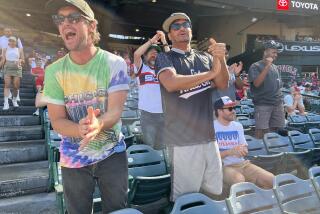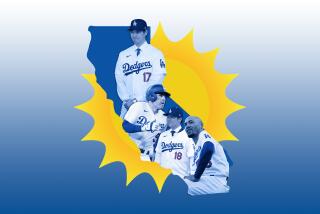Where have you gone, Ernie Banks?
- Share via
Friday was our national day of red, white and blue.
So why not play two?
The Angels played the Blue Jays at Angel Stadium, the skies were blue, the temperature was 86, the stands were full and the smell of hot dogs drifted about.
It was the Fourth of July. The parking lot was full of people in lawn chairs, relaxing and imbibing. Inside, they unfurled a huge American flag in the outfield before the game. A jet flew overhead. It was perfect.
You know what Ernie Banks would have said.
A soldier named Davey Lind threw out the ceremonial first pitch, and it was caught by another soldier, former Marine reserve and current Angels right-hander Justin Speier. Lind’s pitch was as high and hard as you’ll get from somebody who lost both legs in combat in Iraq last year.
Angels Manager Mike Scioscia, heart as big as stomach, made sure that Lind’s moment was more than perfunctory. He took him along to home plate for the pregame exchange of the lineup cards. Soon, Lind’s list of new friends had expanded to new Toronto Manager Cito Gaston and four umpires.
Everything was nice. Why can’t we do this twice?
They once had something in baseball that has gone the way of the spitball and metal spikes. It was called a doubleheader. No, not these concoctions they throw together to make up rainouts. Real doubleheaders.
If you are 45 or older and a baseball fan, you remember. Two games, one day, same price. Not one in the morning and one later at night. Two games, with maybe 20 minutes between. Six or seven hours of entertainment. A family day. Fathers and sons with past and future dreams of being on the field, not sitting beside it.
“I remember, when I was maybe 10 or 11, standing right behind the Phillies’ dugout after the first game,” says Scioscia, who is now 49. “My dad asked if I wanted to get something to eat and I said no. I wanted to watch the pitchers, up close, when they warmed up for the second game.”
For reasons no greater than that, Major League Baseball used to regularly schedule doubleheaders, especially on holidays such as the Fourth of July. No more. Not for more than 30 years.
Doubleheaders died from the perceived need for full revenue from all 81 home games, the resistance of the players’ union and the resistance of television to try to hold an audience that, these days, has video-game attention span and ants-in-its-pants focus.
Still, it is fun to remember the fun.
Item: In 1937, Seattle Rainiers pitcher Dick Barrett won the opener of a Pacific Coast League doubleheader. It was the last day of the season and it was his 19th win. He had a deal with team owner Bill Klepper that if he won 20, he would get a $250 bonus. Klepper ordered Manager Johnny Bassler not to pitch Barrett in the nightcap. Bassler pitched Barrett, Barrett won and Klepper fired Bassler.
Item: In the Tidewater League in 1911, North Carolina teams Elizabeth City and Suffolk played a doubleheader, each getting a home game. The first game started at 10:30 a.m., and when they finished that one, the players boarded a train with the fans and headed for the second game, which started at 4:30 p.m. On the train ride, they ate picnic lunches with the fans.
Torii Hunter starts some Angels fireworks with a home run in the second inning and the Angels really go to work in the sixth. Gary Matthews slices a double inside third base that scores one and Howie Kendrick slaps a single to right-center minutes later that brings home two more.
With five strikeouts and only 81 pitches thrown, Jered Weaver has a 5-0 lead starting the seventh, and the game is only 1 hour 40 minutes old.
Plenty of time to play two.
Item: On July 4, 1939, between games of a doubleheader, Lou Gehrig stood in front of a huge crowd at Yankee Stadium and told them he had been “the luckiest man on the face of the earth.”
Item: Between games of a 1922 Memorial Day doubleheader between the Cubs and Cardinals, Cub Max Flack was traded to the Cardinals for Cliff Heathcote. After the first game, they switched uniforms and dugouts and played for their new team.
In the Angels’ seventh, a man old enough to at least remember the concept of doubleheaders, Garret Anderson, 36, sends his second bomb in three games out of sight in right field and Weaver’s lead is now 8-0. Before the game, Anderson smiles when it is suggested that, were doubleheaders scheduled on Memorial Day, Fourth of July and Labor Day, the season might be shortened by a week.
“I’d vote for that,” Anderson says.
Item: On the last day of the 1941 season, Boston’s Ted Williams brought his average to a rounded-up .400 in the first game of a doubleheader. Instead of sitting out the nightcap and taking his .400, he demanded to play the second game, went four for five and ended at .406.
Item: Stan Musial hit five home runs for the Cardinals in a 1954 doubleheader at old Sportsman’s Park in St. Louis. Sitting in the stands was 8-year-old Nate Colbert. Eighteen years later, playing for the Padres in a doubleheader, Colbert matched the five homers and had 13 runs batted in. After the game, Colbert called his dad, and said, “Remember that doubleheader you took me to . . . ?”
The Angels win, 8-2, and the only disappointment is that the margin of victory is so big that fans don’t get to see Francisco Rodriguez come in to finish, then point to the heavens. Scioscia saves him for saves.
The crowd is 44,021, the Angels’ 12th sellout of the season. The game is over in 2 1/2 hours, plenty of time to play another one.
Instead, fans get a fireworks show, something more attuned to the entertainment taste and pace of today.
Item: In 1992, because of the riots in Los Angeles, the Dodgers had to postpone several games and made them up with three consecutive doubleheaders, July 6, 7, 8. Dodgers Manager Tom Lasorda said, “I loved it. I could never get enough.”
--
Research sources: Larry Stone, Baseball Digest; A Special Doubleheader, Parker Chesson.
--
Bill Dwyre can be reached at bill.dwyre@latimes.com. To read previous columns by Dwyre, go to latimes.com/dwyre.
More to Read
Go beyond the scoreboard
Get the latest on L.A.'s teams in the daily Sports Report newsletter.
You may occasionally receive promotional content from the Los Angeles Times.







